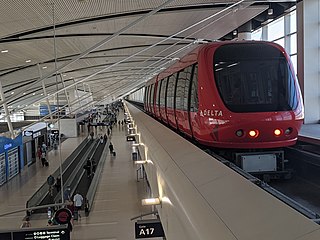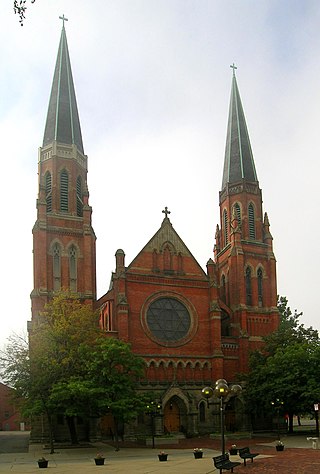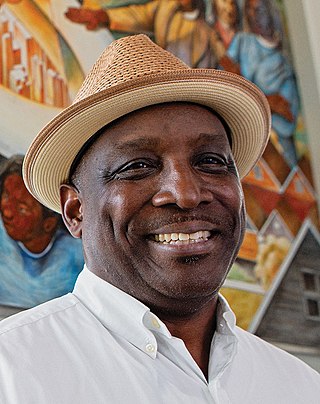History
Detroit's Mexican population began settling in Mexicantown in the 1920s. The Mexican community established itself on Vernor Street. [4] The community was originally known as "La Bagley". [5] The Holy Redeemer Roman Catholic Church began holding weekly masses in Spanish by 1969. At one point, the Lithuanian Hall building was renamed the Hispanos Unidos Hall. [4] Waves of immigration came in the 1970s and 1980s, adding to the community. In the late 1980s, the neighborhood was christened "Mexicantown" as part of a public relations campaign. [5] A wave of immigration from Mexico in the 1990s greatly increased the number of Mexicans in Detroit. [4] In one period, Mexicantown's population increased with seasonal immigrations of about 2,000 people, while Detroit as a whole had population decreases. [6] Benedict Carey of The New York Times said that Mexicantown was "on the rise" in 2005. [7]
In December 2012, Ford Motor Company announced that it would open the Ford Resource and Engagement Center in the Mexicantown Mercado facility and spend $10 million to finance the operations of the center. [8] Prior to the Ford center opening, the building was closed. [9]
Composition
The main thoroughfares are Bagley Street and Vernor Street. Meghan McEwen of Model D said, "Nebulous are the borders of Mexicantown" and that "Some say it begins at the old train station and ends at Clark Park. Others passionately insist it includes Clark Park. More than a few people expand its spread all the way to Livernois." [1] Vince Murray, the executive director of Vince Murray, argued that the community could include Springwells Avenue and that the name "Mexicantown" may be too limiting. [1] McEwen said "Perhaps even more important to defining the neighborhood, though, are its enviously unique traits and robust character, attracting visitors, as well as residents, from all over the state and even Canada." [1] McEwen also said, "Mexicantown is a place where vibrantly colored buildings, decorated with even brighter murals and hand-painted signs, dot" Bagley and Vernor. [1] As of 2011, there are many restaurants at the intersection of Interstate 75 and Vernor that cater to customers from the suburbs. [4] Mcewen said, "One might guess there are more restaurants per square foot than any other neighborhood in Detroit." [1]
A documentary called A Journey to Mexico was created, highlighting travels of people from two Mexican towns to the Mexicantown area of Detroit. [6]
In the game Deus Ex: Human Revolution , the protagonist Adam Jensen was fired from Detroit PD's SWAT after an incident that took place in Mexicantown.
A documentary by Troy Anderson called Clark Park: A Detroit Story, released in 2017, tells the story of the Southwest Detroit community that saved a hockey rink, helped stabilize a neighborhood, and gave inner city youth the opportunity to play the game of hockey. This short documentary with a run time of 34 minutes is told through the perspectives of seven southwest Detroiters ranging from 12 to 87 years of age. [15]

Detroit is the most populous city in the U.S. state of Michigan. It is the largest U.S. city on the United States–Canada border, and the seat of government of Wayne County. Detroit had a population of 639,111 at the 2020 census, making it the 29th-most populous city in the United States. The Metro Detroit area, home to 4.3 million people, is the second-largest in the Midwest after the Chicago metropolitan area and the 14th-largest in the United States. A significant cultural center, Detroit is known for its contributions to music, art, architecture and design, in addition to its historical automotive background.

Corktown is a neighborhood located in Detroit, Michigan. It is the oldest extant neighborhood in the city. The current boundaries of the district include I-75 to the north, the Lodge Freeway to the east, Bagley and Porter streets to the south, and Rosa Parks Boulevard to the west. The neighborhood was listed on the National Register of Historic Places in 1978.

Delray is a neighborhood in southwest Detroit in the U.S. state of Michigan. Its area extends south to the River Rouge, east to the Detroit River, west to Fort Street, and north to Clark Street. The two census tracts that cover the neighborhood had a population of 2,783 at the 2010 census.
The culture of Detroit, Michigan, has influenced American and global culture through its commercial enterprises and various forms of popular music throughout the 20th and 21st century. Its automotive heritage plays an important role in the city's culture.

Holy Redeemer High School was a Roman Catholic secondary school located in Southwest Detroit, at the corner of Junction and Vernor streets, near the Ambassador Bridge to Canada. It was overseen by the Archdiocese of Detroit.

Detroit Cristo Rey High School (DCRHS) is a private, coeducational, Roman Catholic high school in Detroit, Michigan, in the West Vernor-Junction Historic District. It opened in August 2008 and operates within the Roman Catholic Archdiocese of Detroit.

West Vernor–Junction Historic District is a commercial historic district located along West Vernor Highway between Lansing and Cavalry in Detroit, Michigan. The district includes 160 acres (0.65 km2) and 44 buildings. The district was listed on the National Register of Historic Places in 2002.

The West Vernor–Springwells Historic District is a six block long commercial historic district located along West Vernor Highway between Honorah and Norman in Detroit, Michigan. The district includes 80 acres (32 ha) and 28 buildings. It was listed on the National Register of Historic Places in 2002.

The Most Holy Redeemer Church is located at 1721 Junction Street in Southwest Detroit, Michigan, within the West Vernor–Junction Historic District. The church was once estimated as the largest Roman Catholic parish in North America. West Vernor–Junction Historic District is adjacent to Mexicantown and contains a growing Mexican community and resurgent neighborhood.

Transportation in metropolitan Detroit comprises an expansive system of roadways, multiple public transit systems, a major international airport, freight railroads, and ports. Located on the Detroit River along the Great Lakes Waterway, Detroit is a significant city in international trade, with two land crossings to Canada. Three primary Interstate highways serve the region.

Springwells is a neighborhood located in Detroit, Michigan, near the Ford Motor Company River Rouge Plant.

This is a list of trails and greenways in Detroit.

Hubbard Farms is a neighborhood located in Detroit, Michigan. It is located on one of the old plots which used to be a ribbon farm along the Detroit River. It is bound by Clark St to the west, W Vernor Hwy to the north, W Grand Blvd to the east, and W Lafayette Blvd to the south. In 1993, it received its official historic district designation.
Southwest Detroit is a neighborhood within Detroit. Clark Park is a popular park within the Hubbard Farms area of southwest Detroit. It is also well known for Mexicantown, Detroit's vibrant Mexican community.

In 2004 58.5% of the people of Hispanic origin in the Wayne County-Macomb County-Oakland County tri-county area were Mexicans.

Metro Detroit has the following ethnic groups:

Metro Detroit includes Christian, Muslim, Jewish, Hindu, Buddhist, and other groups.

Hubert Massey is an artist of a variety of mediums, and well known for his large-scale installations in the Buon Fresco style. Massey has 15 works of public art throughout the state of Michigan, and has been commissioned by various local organizations including universities, museums, hotels, and the Michigan Department of Transportation. He now resides in Detroit, Michigan with his wife Marquita.
















